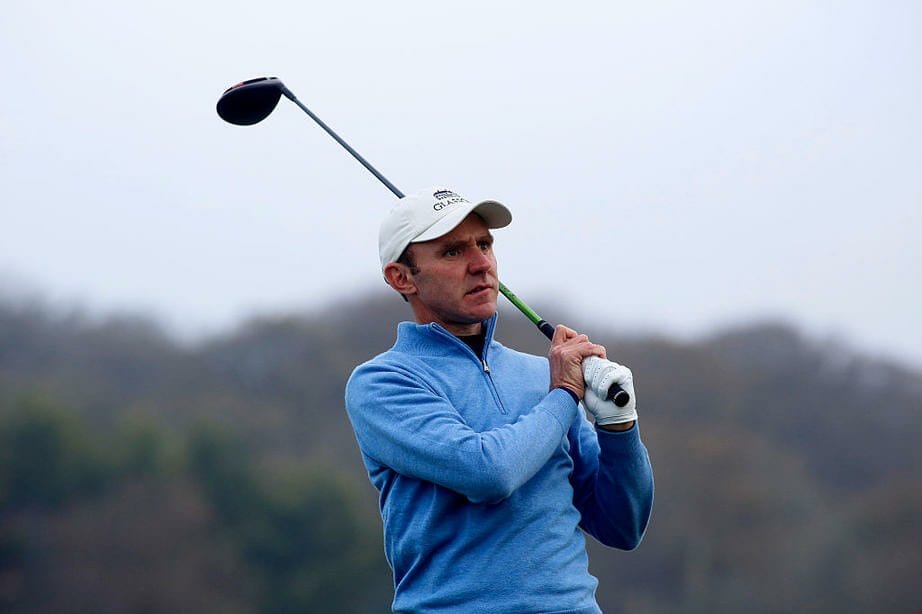Reflecting on the years spent chasing his dream, Colm Moriarty discusses his transition into the professional ranks, lingering regrets and life after golf.
t’s now seven years since Glasson’s Colm Moriarty took a step back from life as a full-time Challenge Tour player. In his own words, Moriarty had become “institutionalised” by the grind of the second-tier circuit, stuck in limbo trying to make that final step up to the Main Tour.
The difficulty of that last leap becomes clear when sifting through Moriarty’s most impressive resume. A glittering amateur career saw him lift numerous match play titles; a South of Ireland Championship, multiple Mullingar Scratch Cups and Walker Cup honours among the highlights before a decorated professional career included over 30 appearances on the European Tour and a victory on the Challenge Tour in Wales in 2007. In 2010, he played the opening two rounds of The Open in St Andrews alongside eventual winner Louis Oosthuizen – Moriarty went on to finish tied 37th.
There was never a question of the Glasson man’s talent or ability, but the fact he fell short of his overriding ambition proves just how tough professional golf can be. In 2012, after over 20 years playing top-flight golf, the time was right for a new challenge for the then 32-year-old who had achieved so much in the game.
“I was out there playing Challenge Tour for eight or nine years,” he recalled. “I think I played about 40 events on the main tour but I never really got a full card where I could plan a season. I held my Challenge Tour card every year, won on the Challenge Tour, but it does come to a stage where you say, where am I going; how long more can I keep chasing it, flying around the world 35 weeks a year?

Colm Moriarty / Image from Getty Images
“It was a difficult decision to make but I’m still happy I made it. I look on tour now, there’s a lot of guys who I played with who are still trying to chase that dream. There’s nothing wrong with that but it just comes to a stage where you need to be clear in your own head as to what you want from the game and I just knew it was my time to move on.”
“I didn’t really want to be someone in my mid-forties jumping from European Tour to Challenge Tour with nothing to fall back on. At some stage you’re always going to come to a point where there’s no golf. Very, very few players make enough money in their career to be able to retire at 45 or 50. So I suppose I was just thinking ahead a little bit.”
Weighing up his options at home, Moriarty knew he wanted to stay involved in golf. In truth, it was all he ever knew and after a few years of soul searching he decided the Irish PGA was the next route for him to take.
“When I was in my early teens, I wanted to be a PGA pro but then I suppose I progressed quicker than I expected through playing international golf for Ireland, the Walker Cup and onto the Challenge Tour.”
“It was never in my mind at that stage when I was playing full-time golf but when I took a couple of years away, I thought, if I want to stay in the game, the only option I have here is to go the PGA route and I’m really happy I did it.”

Colm Moriarty
Despite knowing the game inside out, the transition from the open fairways to the closed walls of the classroom certainly presented a challenge.
“I was never mad into school anyway,” he admitted. “I started my PGA training when I was 35, so I’d been 17 years out of education at that stage. I do remember going over to the Belfry my first year and I remember sitting down in sports science class and thinking to myself, ‘Jesus, what have I got myself into here?’. But I was so focused on getting the qualification and believe me, it’s not an easy thing to do.”
“The course is difficult,” he recalls. “They don’t throw out the qualification willy-nilly like. There’s a lot of work that goes into it. I was a little bit uncomfortable over there at the beginning, you know, and you could feel sorry for yourself if you wanted. But you just had to roll your sleeves up and get the qualification done, and it’s great to have it now. I was very fortunate to complete my PGA qualification under Padraig Dooley at Drive Golf Performance. Padraig is one of the highest qualified and most respected PGA professionals in the country.”
Knowing the pit-falls of life after golf should you not prepare for it, you’d wonder why fledgling pros don’t take the PGA route before flinging themselves into the playing side of the game, but for Moriarty it’s simple.
“Well if you’re 20 and you’ve had a very successful amateur career, it doesn’t seem that glamorous to go and do your PGA qualification,” he confesses. “Chasing the dream is probably the thing to do. And I’d advise any lad to give it a right good shot and go for it.”
“But if you don’t succeed, and you have nothing to fall back on, it’s hard,” he warns. “I’m not saying the PGA qualification is for everyone, but at least it gives you something to fall back on and more should consider it.”
“20 years ago or more, you were either on the Main Tour or the Challenge Tour or nothing. These days there’s somewhere for everybody and you don’t have to have a status in any major tour to be able to find somewhere to play. But as great as the Satellite tours are, they’re not somewhere you want to be long-term – it’s so costly.”
“They’re never going to turn around and say to you, ‘do you know what, you’ve been out here for ten or so years and not moving on, maybe you should do something else’. They want lads to keep teeing it up and chasing the dream. The margins are so fine that lads are willing to back themselves and take that risk.”
Yet when he goes to bed at night, is there ever a hint of regret for a man who chased that dream to have not hunted it down that bit more?
“No, not at all,” he insists. “It’s only been seven years since I stopped playing and in that time, the difference in the way guys are approaching golf is huge. A lot of young guys’ power, strength, distance is all that matters and the way the courses are being set up, it’s becoming a lot more of an advantage than it was to hit it long.”
“It’s different, accuracy just isn’t really seen as something that’s as important anymore. It’s ‘get up there and wallop it as far as we can’. And when I was playing, there was a couple of guys who were long. Now, there’s half the field who are hitting the ball a mile. I don’t know if the scores have come down that much or if the skill level, as in the skill level of getting around a course, has increased that much, but it’s definitely a changing game.”
And why should he have regrets? Now a fully qualified PGA professional who finished 4th on the Region’s Order of Merit in his season this year, Moriarty won more events than anybody on the circuit this term and played in 34 different Pro-Ams. However, in terms of brass taxes, that all adds up to less than €30,000 before expenses. A tough pill to swallow?
“It’s an adjustment but I’m focused on other areas now outside the playing elements. I want to expand the corporate side of what I can offer.
I’m attached to Glasson and I do a lot of teaching here and want to expand that. The playing side of the region is never going to be enough on its own to sustain a career but I have always been very lucky with support.”
“I have had a great relationship for a long time with Tom Reid and everyone at Glasson, and they’ve been a huge supporter of me right from day one when I turned pro. Playing the circuit I have met so many great people over the last couple of years and I have actually got my current sponsors (Murray Timber Group and Connolly’s Red Mills) through playing with them.”
“I played with Brendan Penney who’s the financial controller at Murray Timber a few years ago and it grew from there. Bill Connolly of Connolly’s Red Mills, is one of the biggest supporters of the Irish region, long before I was involved; he has supported the region no end and we’re all very grateful.”
Still, it’s only natural after such a long career that you can look back on certain things with a tinge of regret. For Moriarty, it was how he handled the transition from amateur to professional, though inexperience played its part.
“I probably questioned myself too much straight away. You need to trust what got you there. It’s different, no matter what anybody tells you but I achieved a lot as an amateur and probably didn’t trust what got me to that next level.”
“It’s fine if you hit the ground running and you get a status and you’re out on the Tour but if all of a sudden and you go to Q-School like a lot of lads do in their first year out and they miss out, straight away, you’re thinking, ‘oh, I’m not good enough, I need to change X, Y and Z, I need to change my swing’, and next thing you’re lost.”
However, Moriarty certainly isn’t lost anymore and now a teacher of the game based out of the magnificent new practice facilities at Glasson, he houses a wealth of experience that he’s ready to pass on to the next generation of aspiring professionals.
“I really enjoy the coaching but it’s a crowded market. If you type into Google ‘how to swing a golf club’ or ‘improve my back swing’, you’ll get 10,000 different ideas on how to do it; some right and some totally wrong!”
“Sometimes people can go for lessons and their enjoyment of the game can actually diminish. I often ask students, ‘do you want to have a swing that looks really good or do you want to be able to go out, enjoy your golf and shoot a good score?’”.
“Lots of guys focus solely on technical coaching and making people look like they have a better swing and go with the current trends. But I actually want to try and improve people to get the best out of their natural ability; simply teaching them how to get the ball around the course in less shots. That might be too simplistic for some people these days, but that’s what golf in its most simplistic form is.”
Having sat down with Colm, it’s probably due to his vast experience that he can now simplify our most complex game. One or two shots less here or there could have made all the difference to his own playing ambitions, his resume reads well regardless. Having refused to turn his back on the game he loves, he enters this new chapter of his career with a mine of information at his disposal, and no doubt those who visit him will only benefit from his knowledge. We wish him every success.
























Leave a comment